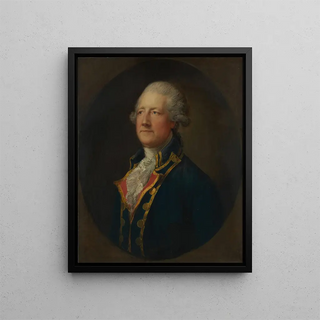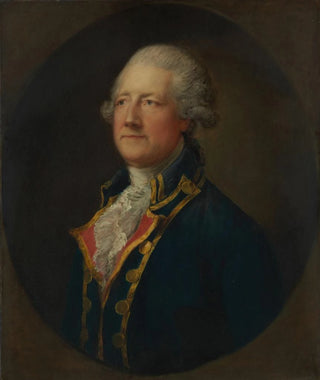Art print | John Hobart 1723-1793 2nd Earl of Buckinghamshire - Thomas Gainsborough


View from behind

Frame (optional)
In the fascinating world of 18th-century British painting, the "John Hobart 1723-1793 2nd Earl of Buckinghamshire" by Thomas Gainsborough stands out for its depth and elegance. This portrait, capturing the essence of an influential statesman, reflects a time when art and politics were intricately intertwined. Through this painting, Gainsborough invites us to delve into the life of an aristocrat whose face is marked by dignity and wisdom. The artist's technical mastery, combined with a keen sensitivity to psychological nuances, makes this work a true masterpiece.
Style and uniqueness of the work
Gainsborough's style is characterized by a naturalistic approach and a subtle palette that evokes both light and shadow. In this portrait, the Earl of Buckinghamshire is depicted with particular attention to detail, whether in the rendering of the textures of his clothing or in the expression of his gaze. The composition, balanced and harmonious, highlights the majestic stature of the subject while incorporating landscape elements in the background that add an extra dimension to the scene. This choice of background, typical of Gainsborough, reinforces the idea of a connection between the individual and nature, thus emphasizing the values of the enlightened aristocracy of the time. The carefully manipulated light plays a crucial role, illuminating the face of the Earl and creating an atmosphere that is both intimate and solemn.
The artist and his influence
Thomas Gainsborough, born in 1727, is one of the most influential painters of his era, known for his ability to capture the beauty and personality of his subjects. His work marked a turning point in English painting, moving away from rigid conventions of academic portraiture to embrace a more free and expressive approach. Gainsborough established a dialogue between portrait and landscape, an innovation that inspired many later artists. His painting technique, characterized by fluid brushstrokes and a particular attention to light, paved the way for more modern styles.

Matte finish

View from behind

Frame (optional)
In the fascinating world of 18th-century British painting, the "John Hobart 1723-1793 2nd Earl of Buckinghamshire" by Thomas Gainsborough stands out for its depth and elegance. This portrait, capturing the essence of an influential statesman, reflects a time when art and politics were intricately intertwined. Through this painting, Gainsborough invites us to delve into the life of an aristocrat whose face is marked by dignity and wisdom. The artist's technical mastery, combined with a keen sensitivity to psychological nuances, makes this work a true masterpiece.
Style and uniqueness of the work
Gainsborough's style is characterized by a naturalistic approach and a subtle palette that evokes both light and shadow. In this portrait, the Earl of Buckinghamshire is depicted with particular attention to detail, whether in the rendering of the textures of his clothing or in the expression of his gaze. The composition, balanced and harmonious, highlights the majestic stature of the subject while incorporating landscape elements in the background that add an extra dimension to the scene. This choice of background, typical of Gainsborough, reinforces the idea of a connection between the individual and nature, thus emphasizing the values of the enlightened aristocracy of the time. The carefully manipulated light plays a crucial role, illuminating the face of the Earl and creating an atmosphere that is both intimate and solemn.
The artist and his influence
Thomas Gainsborough, born in 1727, is one of the most influential painters of his era, known for his ability to capture the beauty and personality of his subjects. His work marked a turning point in English painting, moving away from rigid conventions of academic portraiture to embrace a more free and expressive approach. Gainsborough established a dialogue between portrait and landscape, an innovation that inspired many later artists. His painting technique, characterized by fluid brushstrokes and a particular attention to light, paved the way for more modern styles.






